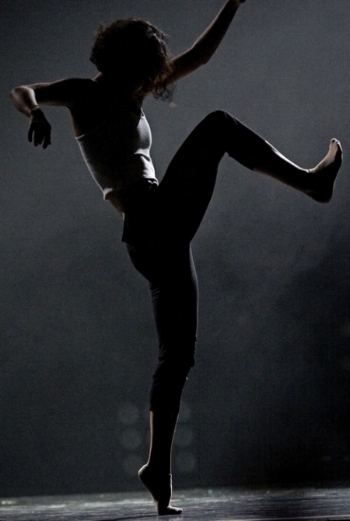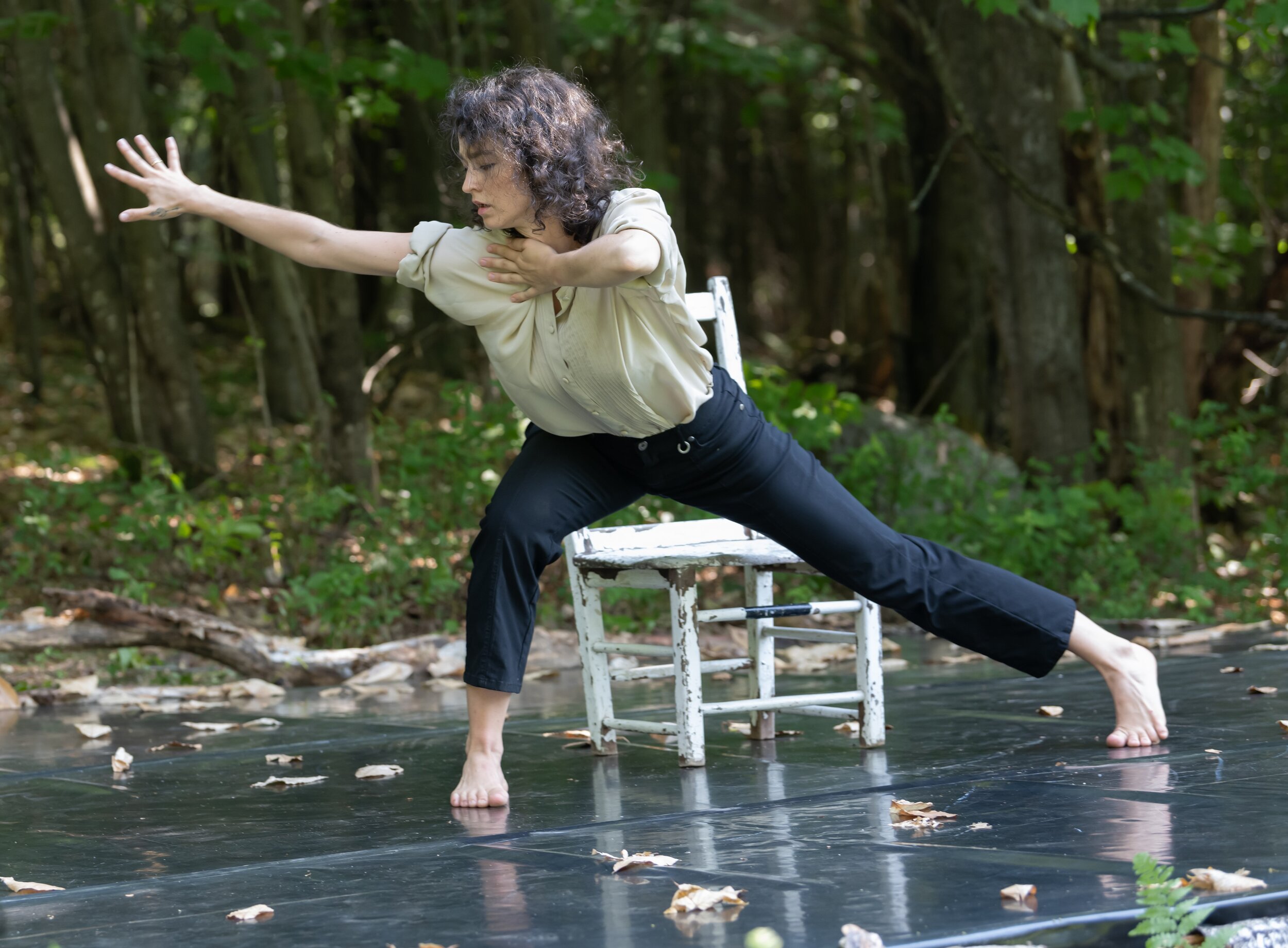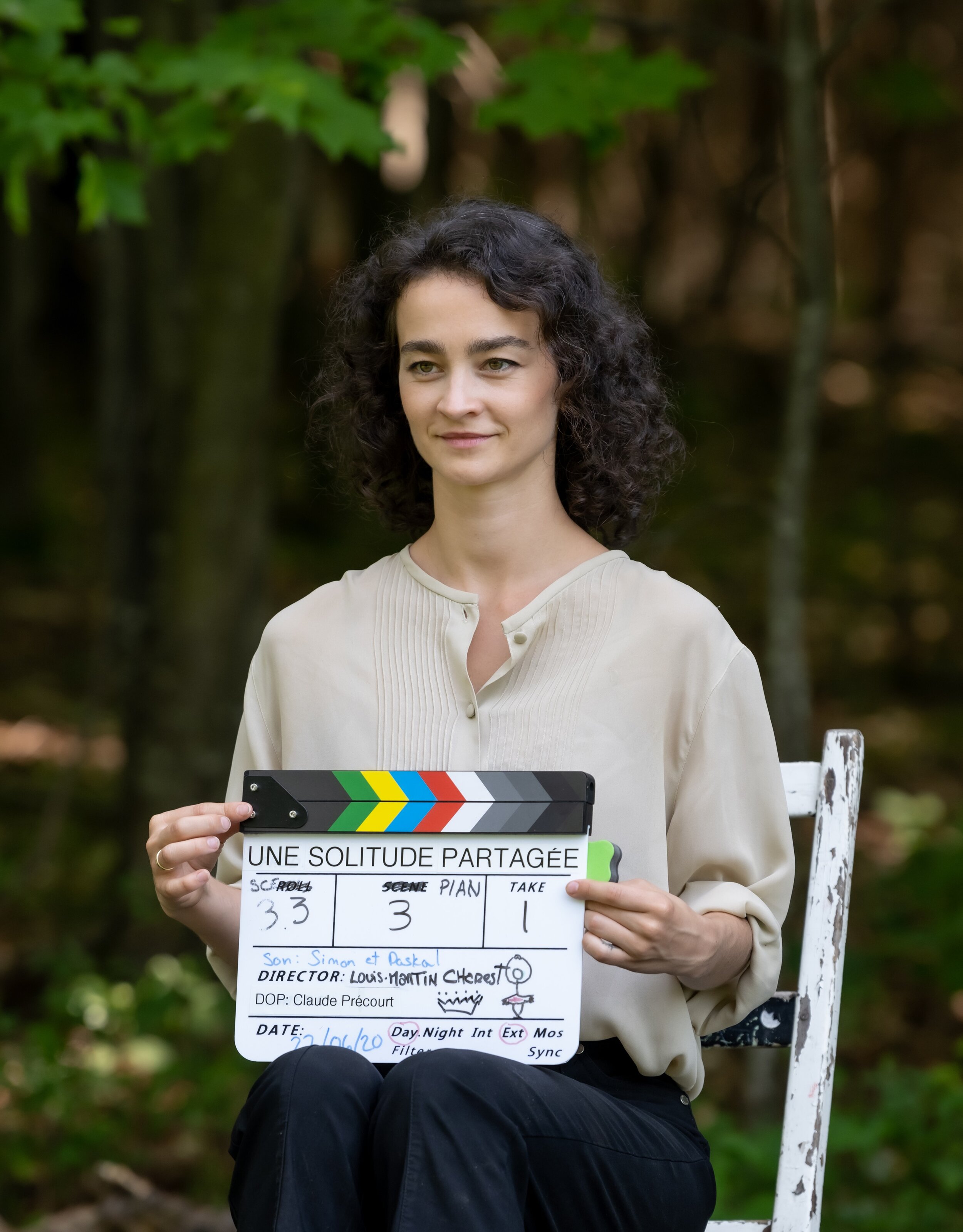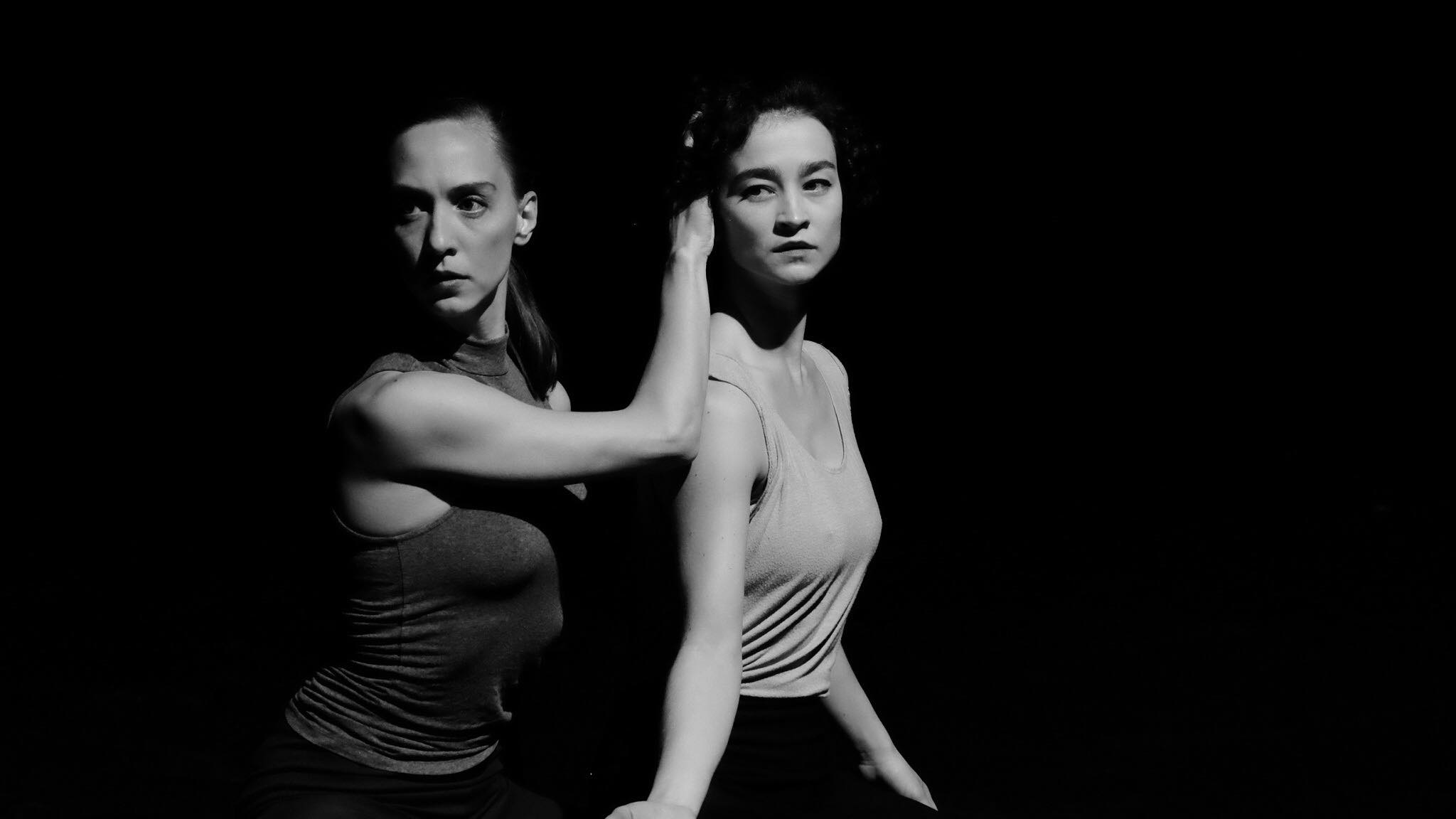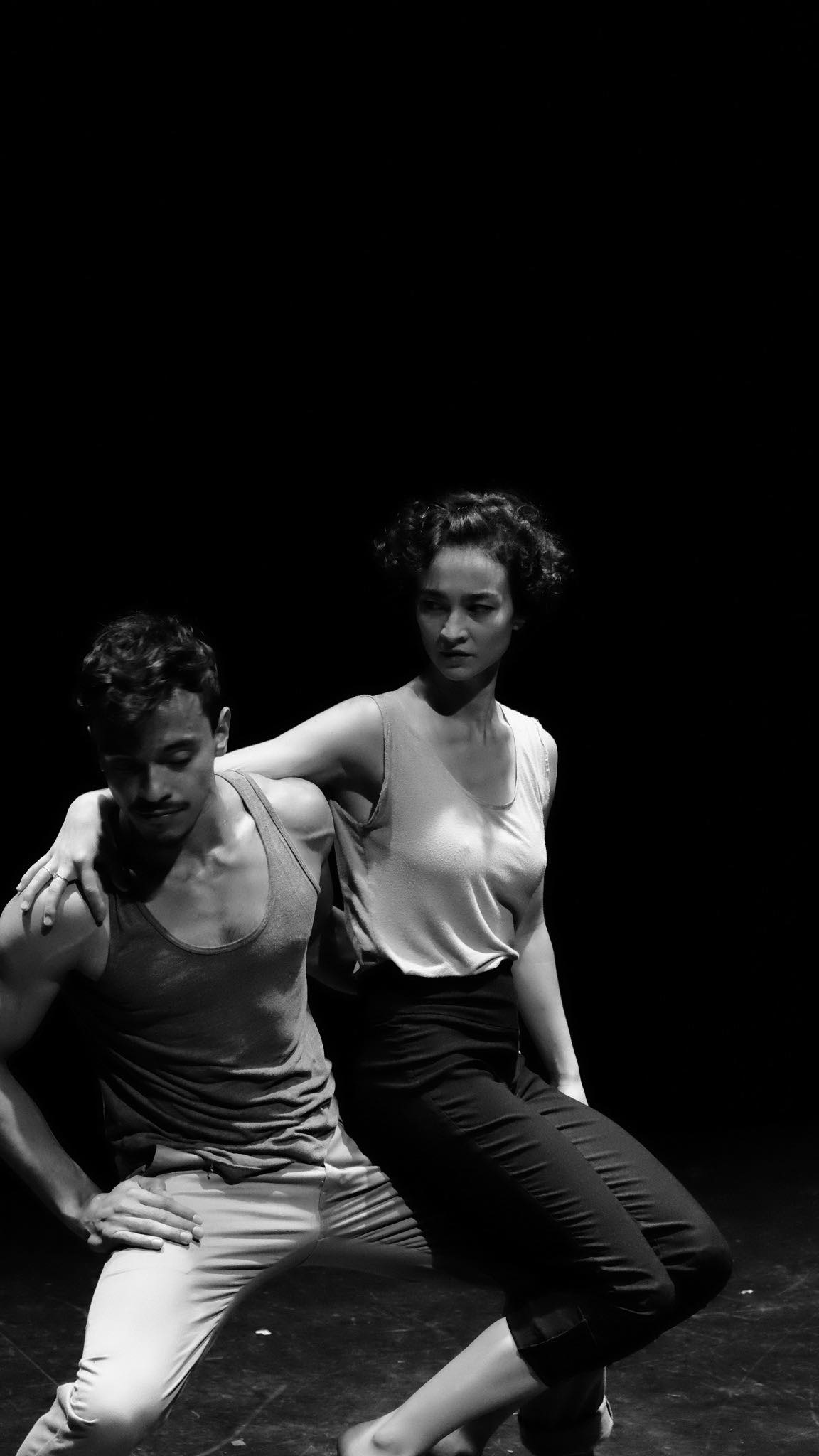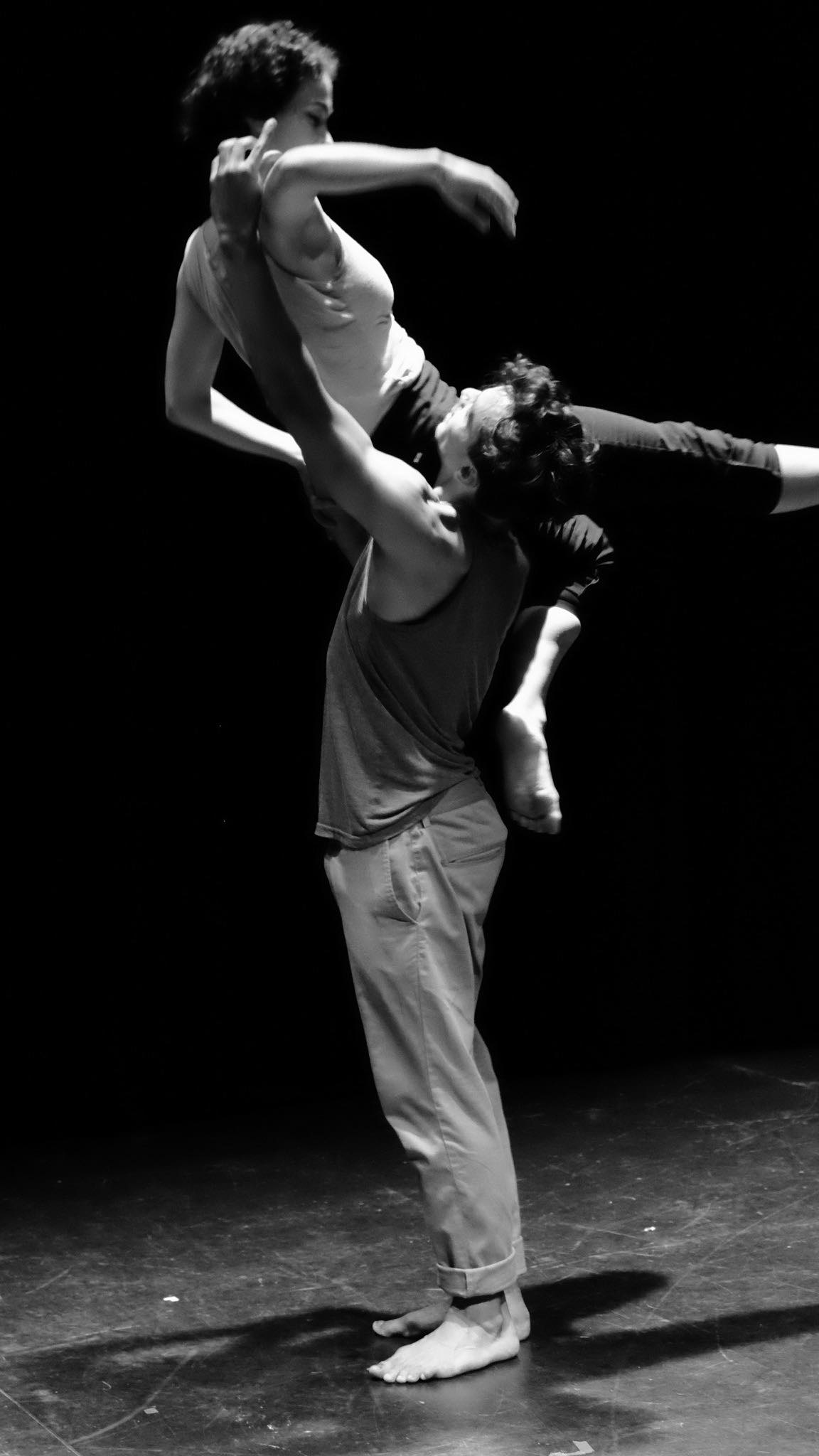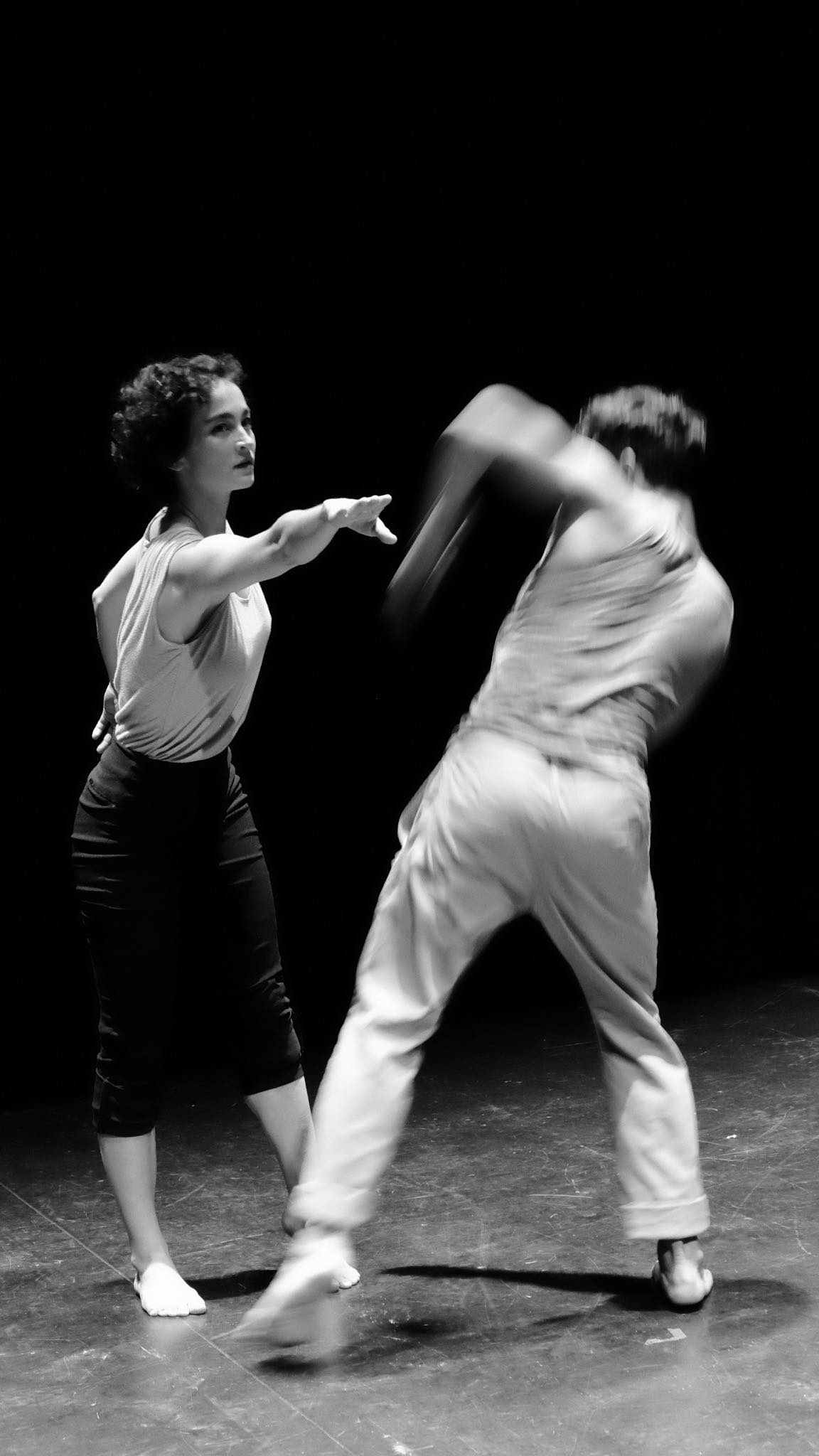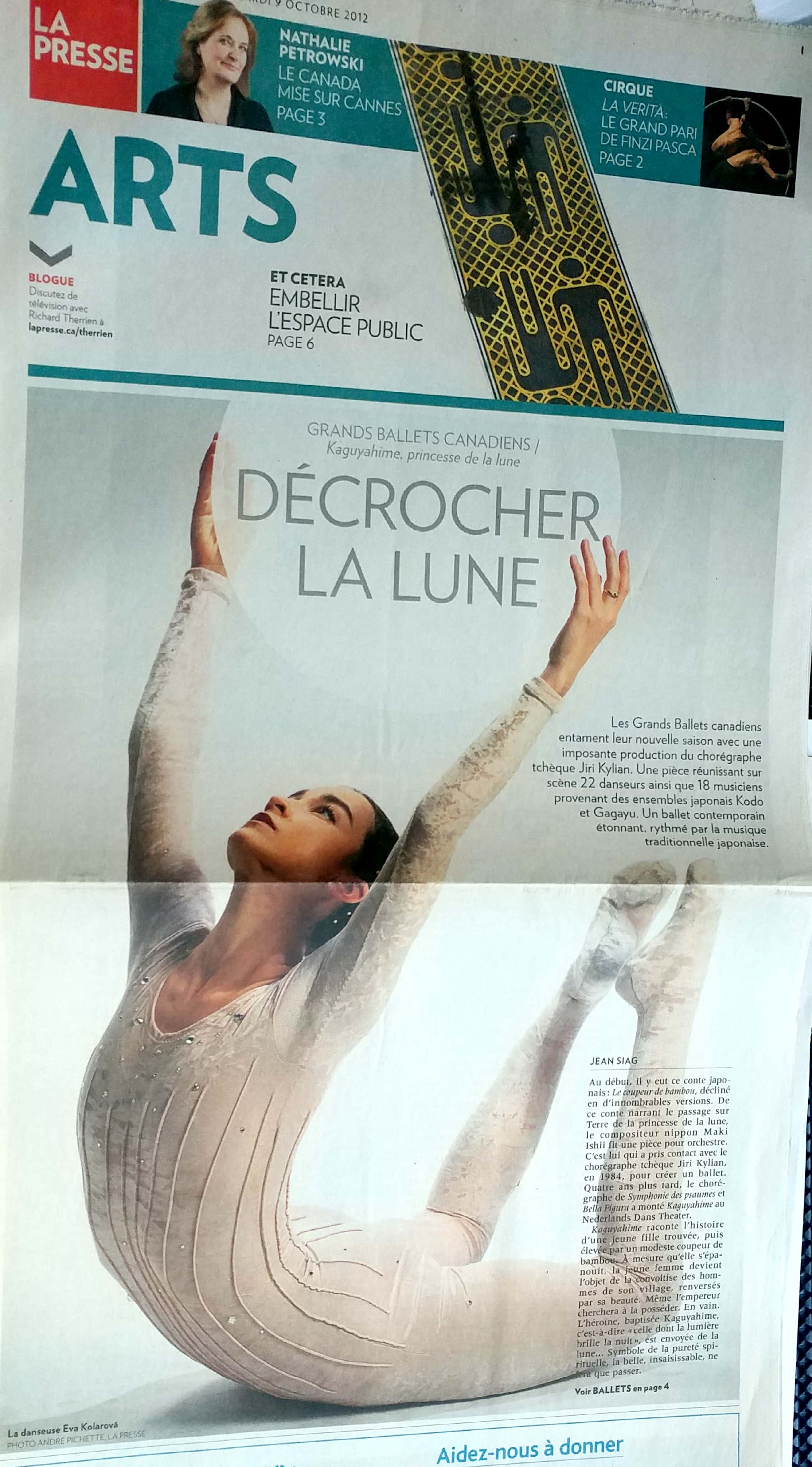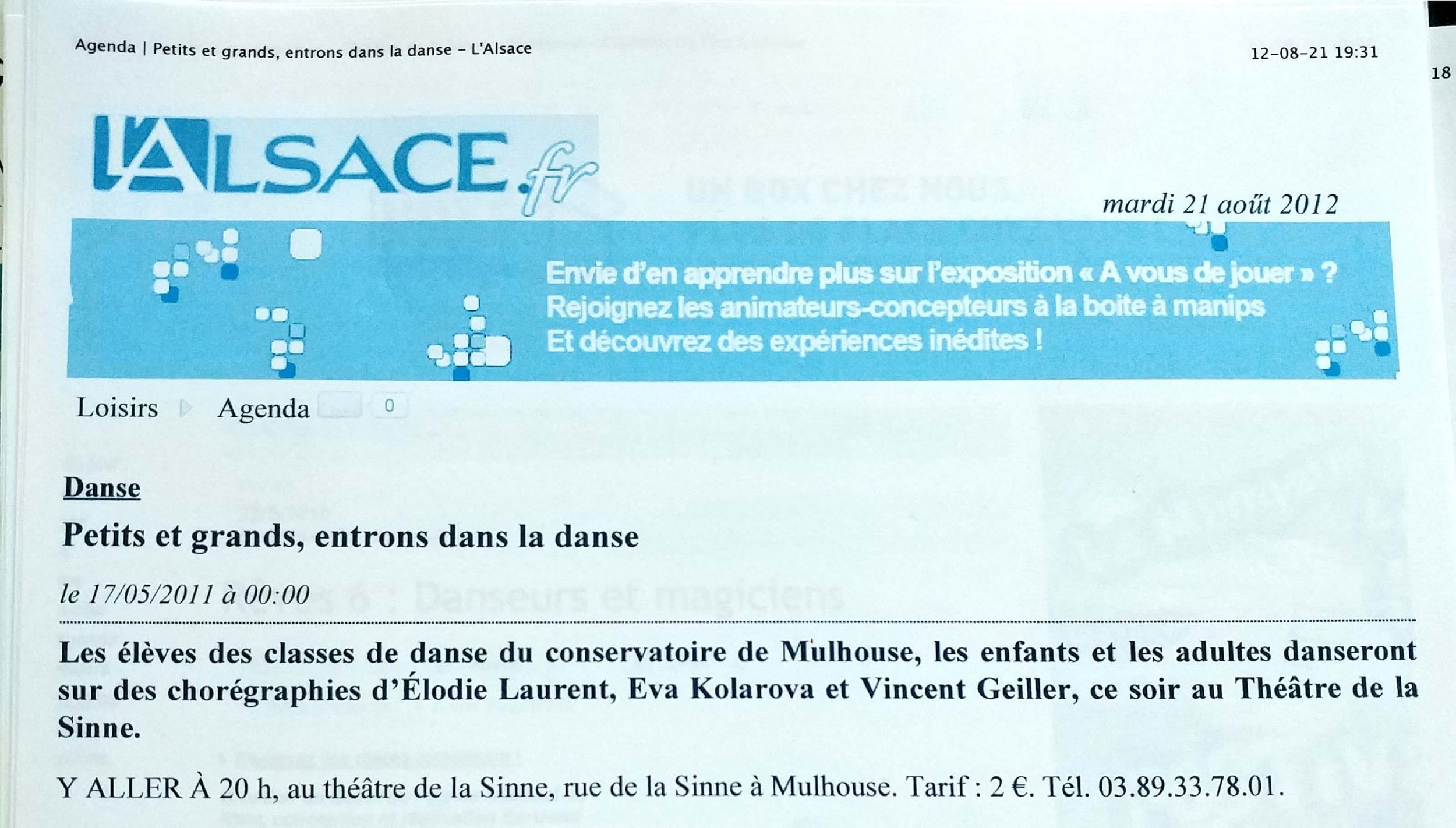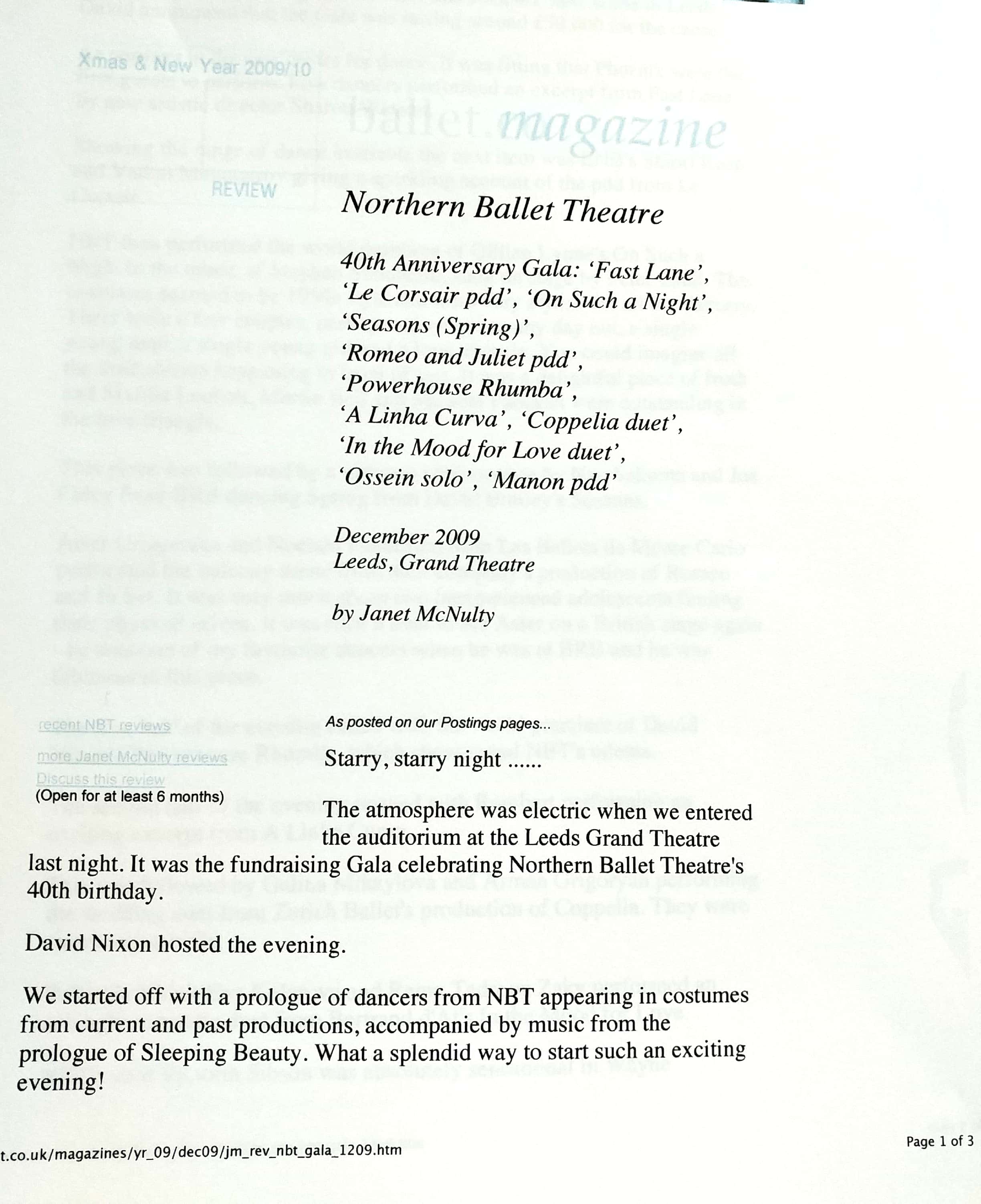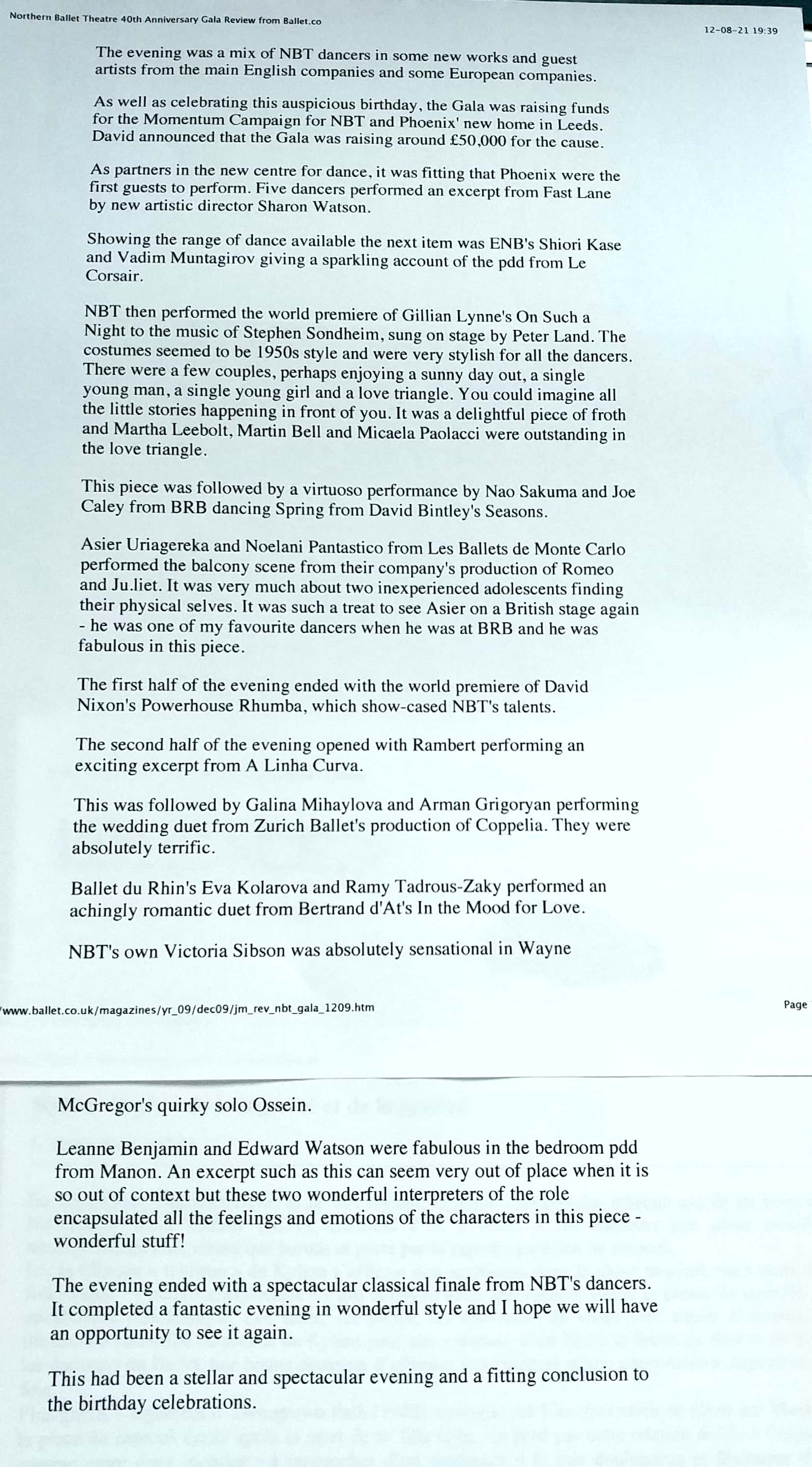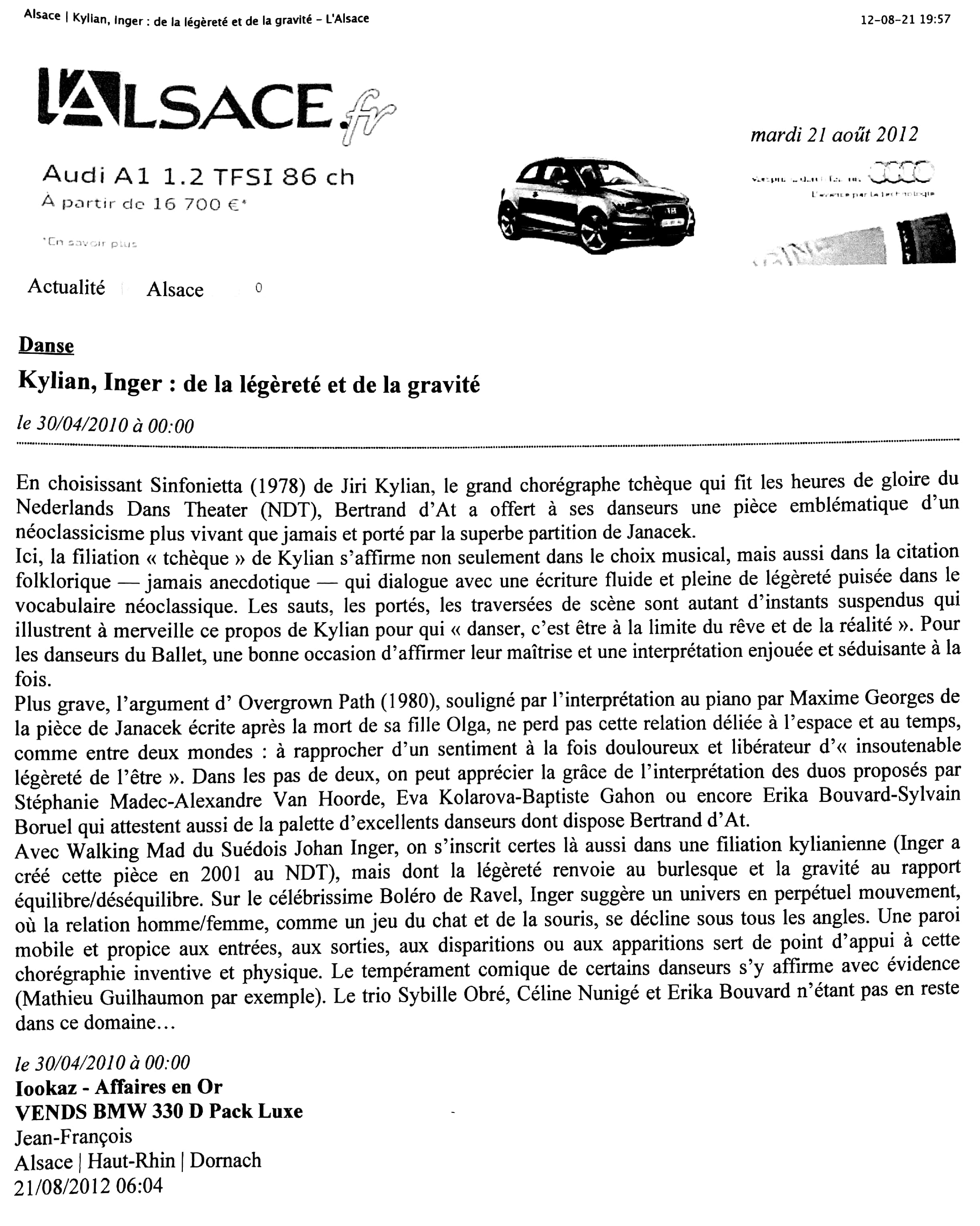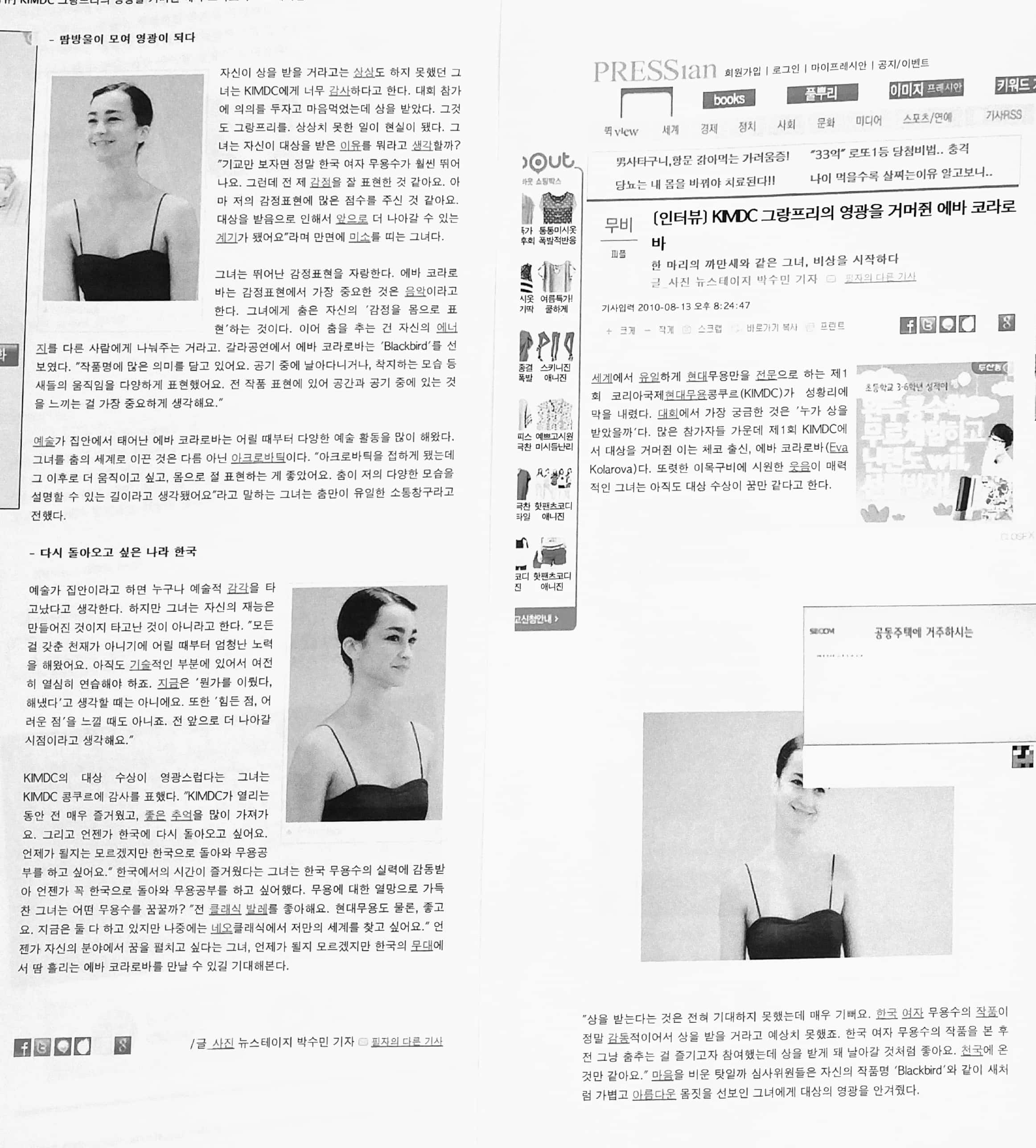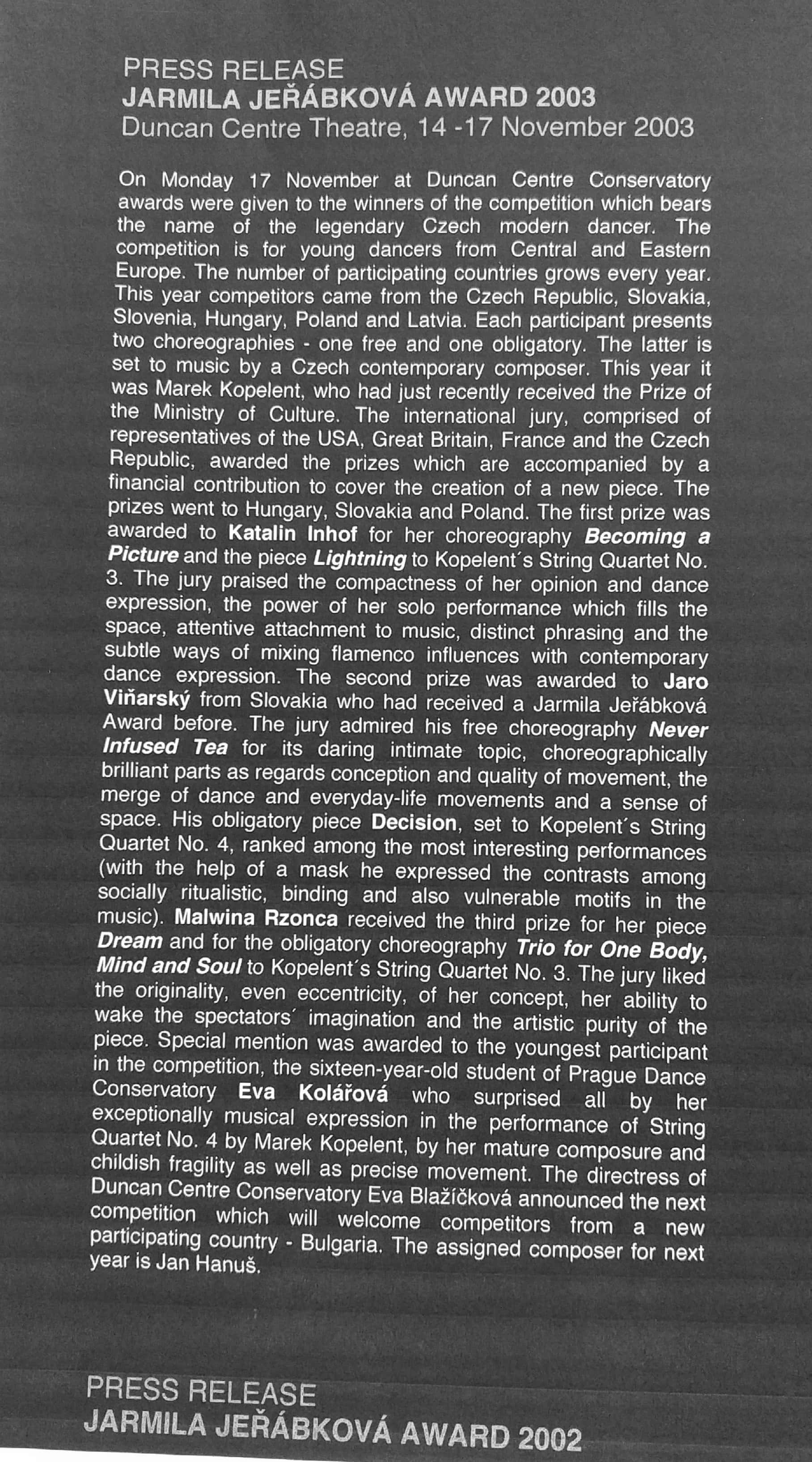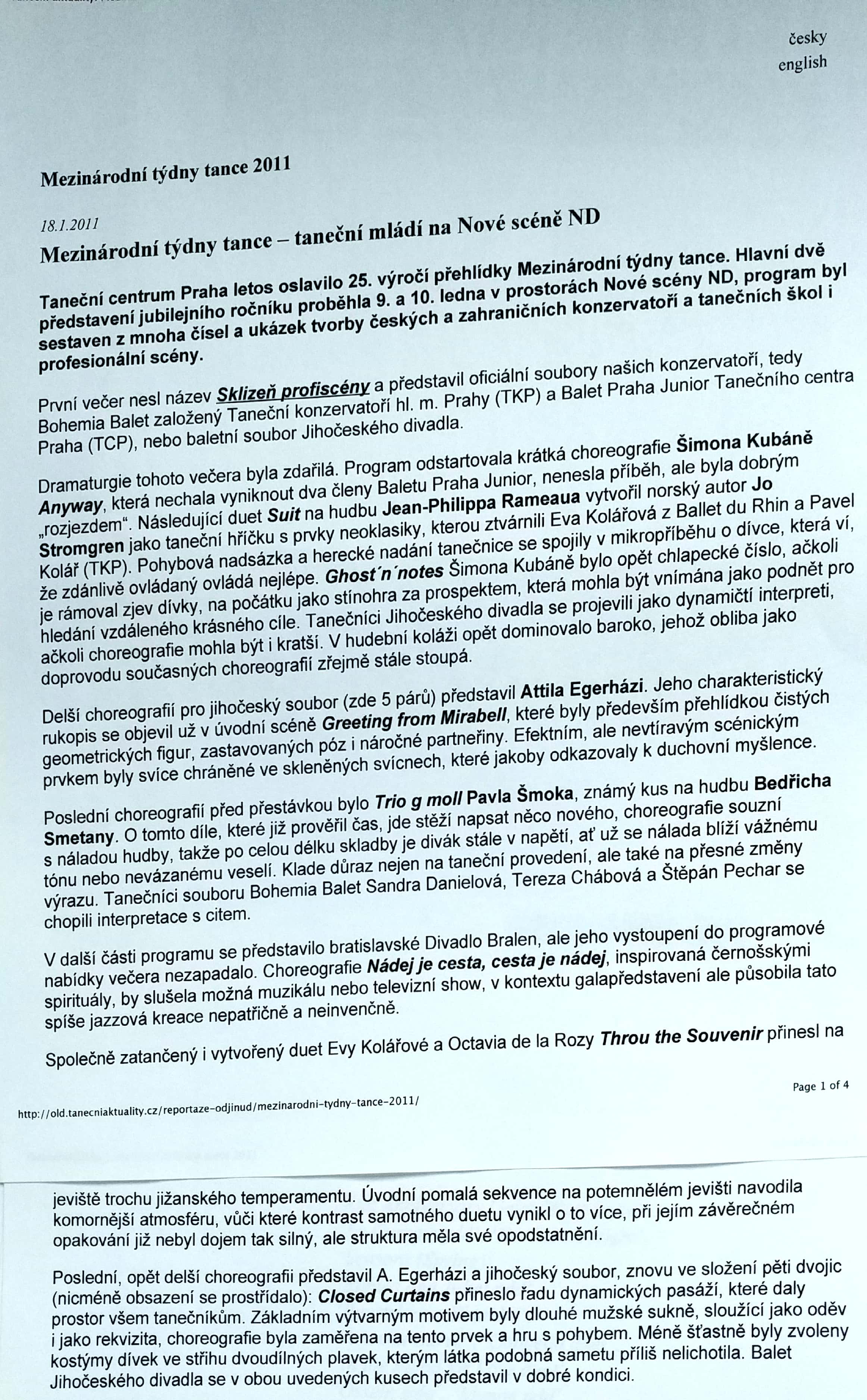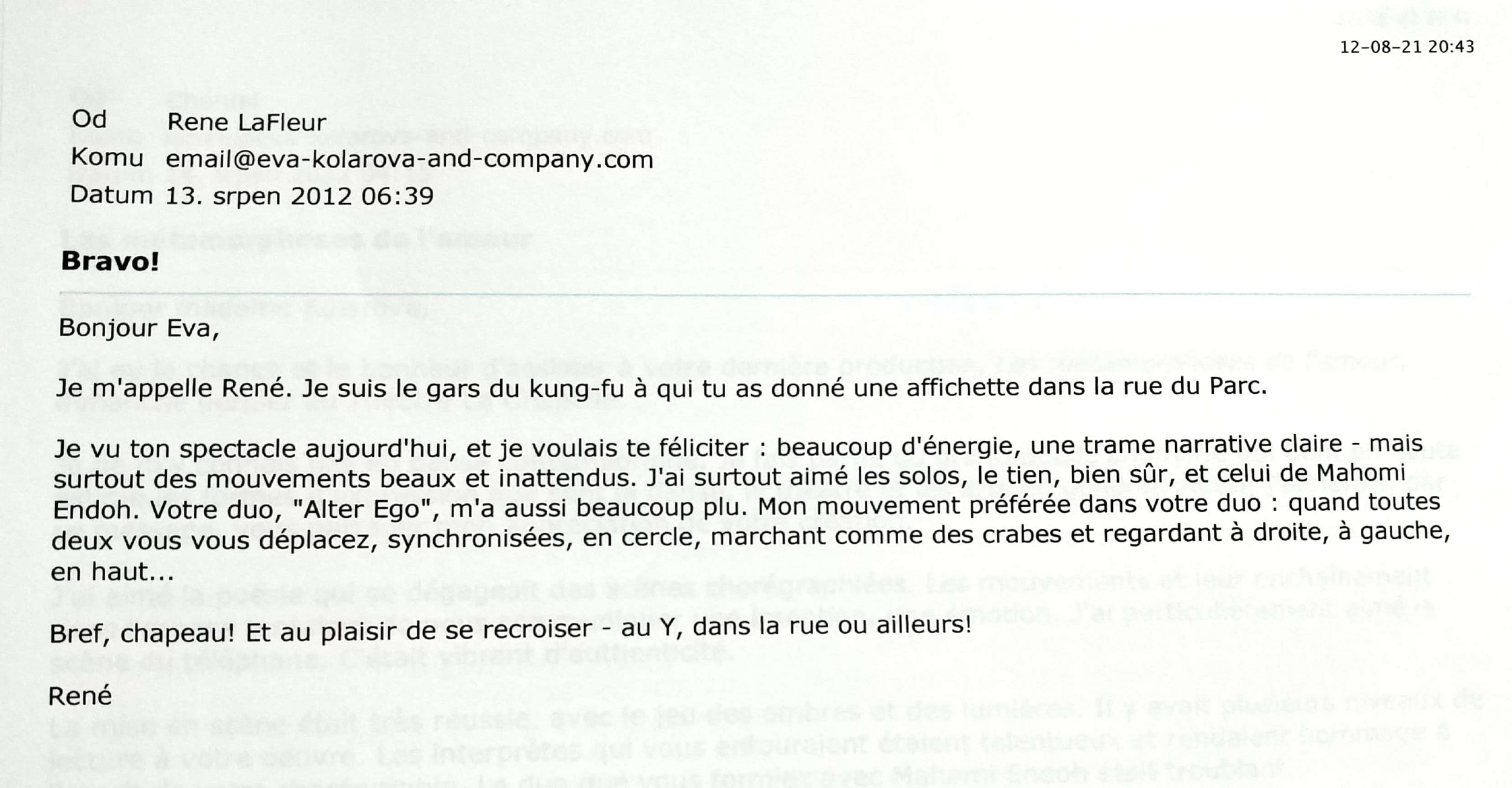PRESS after premiering my recent new dance video project a solo entitled Inner Dialogue
Performed within the project SHARED SOLITUDE organized by The Festival des Arts de Saint-Sauveur.
CHRONIQUE DE DANSE:
http://www.chroniquesdedanse.com/critiques/inner-dialogue/ fbclid=IwAR24JDasEHFKVHkXrusy122B_qxcP7w04ppfnhicW18fQq_zEcDuPVwBdxg
Quant à Eva Kolarova, d’origine tchèque, ex danseuse de compagnies de ballet prestigieuses (Opéra national du Rhin, Les Ballets Jazz de Montréal et les Grand Ballets Canadiens), Guillaume Côté, directeur du Festival, la questionne en visio conférence : « Y aura-t-il un changement particulier à l’issue de cette période ? » Notant la dimension « historique » de la situation, Eva – par nature optimiste – souligne que c’est aussi un temps propice à s’arrêter, à regarder ce que l’on essaie souvent « de ne pas voir » ; c’est à dire une deuxième chance pour une introspection…suscitant des actions.
Sur fond de bruit de clapotis d’un lac et d’images d’un parc empli de promeneurs, les deux femmes -Eva et Maggie – expriment leur motivation et leur enthousiasme réciproque dont, pour la danseuse, des essais à domicile avec et autour d’une chaise, réfléchissant alors à « un voyage intérieur » et à une approche différente de l’espace. Matériellement restreint à la maison, il se conçoit aussi en tant que déploiement large de son esprit, dit-elle en ouvrant généreusement ses bras aux seuls sons du cor. Les variations tonales vont des graves profonds aux notes plus hautes chargées d’espoir, stimulant l’imagination de la danseuse…………..
Ballet Kelowna - dancers
PRESS before and after new work created for Ballet Kelowna, AS IT IS.
CAPITAL NEWS:
The audience is taken to the other side of love, where yin balances yang. The dancers intertwine themselves in a contemporary ballad of self-love in "As it is".
“I thought about relationships and for me, I don’t want to talk about the stereotypical love story.
Seeking a relationship should never be without first understanding of who we are [alone], which is not the same as being lonely. Being lonely is a social construct a result of isolation," said choreographer, Eva Kolarova.
GLOBAL NEWS:
Ballet Kelowna presents Twilight: a story of love and connection
The program will showcase top emerging choreographers Eva Kolarova and Kunal Ranchod
Ballet Kelowna contemplates love and connection to people and places with the expressive and moving mixed program Twilight, presented at the Kelowna Community Theatre on February 14 and 15.Twilight will showcase a range of different contemporary and classical works as well as world premieres from two of Canada’s most well-regarded emerging choreographers.Choreographer Eva Kolarova will be performing a contemporary piece, As it is, exploring ideas of loneliness and separation, and the urgency to form relationships with others. Within the Golden Raga, an elegant balletic work will be performed by Kunal Ranchod.
The program will also include the premiere of On Wings by the highly-regarded, three-time Ballet Kelowna collaborator and choreographer Joe Laughlin.“With Twilight, audiences will be guided on a spiritual and emotional journey, exploring the multi-faceted qualities of love and relationship in its many forms,” says Ballet Kelowna’s Artistic Director and CEO Simone Orlando.“Featuring new works by some of Canada’s most celebrated new dance talents, as well as the introduction to a moving piece first performed by Ballet BC, Ballet Kelowna continues to play a vital role in the development of Canadian choreographic talent by offering commissions to both emerging and established artists.
The show starts at 7:30 p.m. on both Feb. 14. and 15 at the Kelowna Community Theatre.
DAILYCOURIER:
before:
“With Twilight, audiences will be guided on a spiritual and emotional journey, exploring the multifaceted qualities of love and relationship in its many forms,” said Simone Orlando, Ballet Kelowna’s CEO and artistic director.
Kolarova has a fascinating nomadic history: born in the Czech Republic, studying dance in Switzerland and Germany, touring for many years as a dancer, presenting her choreographed works at festivals around the world and establishing Kolarova Danse company in Montreal in 2015.
Connecting with new people and new places became second nature.
“I left my country when I was 14. I was kind of thrown into the wide world. I’ve been travelling every since. For me, I always question where is my home? But with the years of coming (and going), I think I can bring my home with me. Home is where the heart is,” she said moments before Ballet Kelowna’s partial preview of the three works at its Studio Series last Friday.
“I came to the conclusion that there is a big difference between being alone and being lonely.
Loneliness is more of a social construct. It is the society which makes us feel lonely. In the end, we are part of everything; we are part of the community; we are part of nature,” she said.
“Nowadays, there is this pressure for dating, finding this other half, always being with someone. But it is a problem because we don’t actually have time to get to know ourselves and to be alone -—which is OK — and to be comfortable with it.”
Kolarova’s choreographic style is to encourage the 10 professional dancers to bring their individuality to the work.
“In the ballet world, there is this unification: we make the dancers look the same or do the same old (classical dance). I really wanted them to challenge themselves, to be like: ‘OK, who are we? Who am I as a person?’ Embrace ourself first and from there, how can I connect or have this beautiful relationship?”
One segment involves “running away from ourselves, our alter ego, the part which says: ‘You are lonely; you are alone; go and find someone,’” Kolarova added with a laugh since she broke up with her boyfriend while preparing the work.
after:
This is Ballet Kelowna’s Twilight, three dynamic works with the theme of love from three Canadian choreographers who are not only refining but redefining their blend of classical and contemporary dance.
Choreographers Joe Laughlin and Eva Kolarova brought their exploration of romantic love and self-love to the company’s 10 exceptional dancers. But this was not your lock-in series of highly technical dance movements.
In an intimate rehearsal setting, both talked about the different kinds of love that each individual dancer could bring to the performance, what love means to each of them, and urged them to challenge themselves.
The result was an incredible investment in the work by the dancers, rewarded with standing ovations at Kelowna Community Theatre on Friday and Saturday.
Simone Orlando, Ballet Kelowna CEO and artistic director, set the tone in her introduction: each of the three works is “very different.” The anticipation among more than 500 fans on Friday was palpable. They didn’t have long to wait for totally different.
The finale was Ballet Kelowna’s commission of the quirky As It Is by Montreal choreographer Kolarova. Mid-piece, dancer Valentin Chou came to the edge of the stage and used a microphone to engage in a discussion about self-love and loneliness with an audience that was not expecting a Q&A. He also tried in vain to interview dancers frozen in place on stage.
It too was technically challenging.
Twilight was indeed as Simone promised: “A spiritual and emotional journey, exploring the multifaceted qualities of love and relationship in its many forms.”
CASTANET:
________________________________________________________________________________________________________
PRESS - Post show review from John Nyman after performing at Toronto Festival Dance made in Canada, where I danced my new solo Stream of Light.
http://www.briband.com/psn/2019/8/20/uqqaub4e4kx990n12axgf3u1pd5jmt
PRESS 2019 MONTREAL FRINGE FESTIVAL COVERAGE
before and after RE_IMAGINE
Montreal Gazette
https://cofestival.net/montreal-fringe-competition-dances-alongside-the-sting-montreal-gazette/
CURTAINS up
https://curtainsup.tv/montreal-fringe-for-all-showcases-bold-and-promising-talents/
Montreal Theatre Hub
Celine Cardineau / 2019 Fringe Reviewer at Montreal Theatre Hub
Fringe Review: “Re-Imagined”: A Colourful Everyday Embodiment of Philosophy
2019 MONTREAL FRINGE FESTIVAL COVERAGE
June 15, 2019 Celine Cardineau
In this short dance piece, international choreographer Eva Kolarova presents “Re-Imagined,” an excerpt from a contemporary ballet. As a stand-alone piece, it breathes relatable representations of love and loneliness, corporeality and connection, self and other, life and death, and other experiences of human existence.
Performed by Kolarova, Jerimy Rivera, and Ashley Werhun in an intimate black box setting, this existential choreography displays Kolarova’s reputedly unique “hybrid dance vocabulary.” Incorporating both classical and contemporary techniques, the choreography features stunning lifts, embraces, and spins, as well as deliberate laughter, smiles, and eye contact. Sometimes, the dancers simply cross the stage, like a fleeting passerby. Sometimes, they reach toward the unseen audience, searching for connection or perhaps something deeper beyond our gaze. Sometimes, they run in place, as if being called, alone, toward something. Sometimes, they allow themselves to fall, or to swim through existence.
“Re-Imagined” is a simple yet vibrant production that simultaneously provokes thought and stimulates the senses. Its use of sound and lighting create a multi-sensory experience, while also piquing the audience’s intellect. The lighting design creates a sense of magical realism, with brightly saturated yellow and blue washes, and wide dream-like spotlights, framed by columns of black drapes. The costume design—street clothes with red socks—gives the bodies onstage a vibrant everydayness.
The dancers move to music, silence, and Alan Watts lectures on philosophy, metaphysics, and. spirituality. The spoken score interestingly the viewer’s inner voice attempting to interpret the abstract movement before them. Instead, in the split activity of listening to a lecture and observing complex choreography, the mind must allow the one to interpret the other, whatever correlations or discrepancies may arise.
The first solo is scored to Alan Watts speaking about death, the interval of life, while a soft piano plays. Kolarova’s choreography complements Watts’ imagery of the crests and troughs of a wave. Movements with mandala-like symmetry contribute to a beauty both mathematical and poetic, observed and imagined. The next excerpt from Watts’ lectures is on the subject of the Self and Other, the inside and outside, coming together to form “one total body,” and the feeling of being alienated from one’s environment. These relatable philosophical musings act as questions burning within the different characters onstage. Watts also speaks of the difference between seriousness and sincerity; the former being a “kind of gravity,” while the latter is godlike in its playfulness and lightness. An intimate duet between dancers embodies the intermingling between gravity and levity, as they play with tension, weight, and centripetal force.
Kolarova’s choreography artistically represents elements of human experience: intimacy in the face of existential uncertainty; connection between strangers, however forced, desperate, awkward, sweet, or unreciprocated; or how people learn from each other, imitate each other, thinking others have life more figured out.
Although only just 25 minutes, the piece follows a cyclical narrative, as the last moment brings us full-circle to the first moment. Given this cyclical structure, as well as the richness of the images in between, “Re-Imagined” is definitely a show that merits being seen twice.
Photo by Romain Lorraine
PRESS before and after the show BLUE DEPENDENCE
INTERVIEW with ONE LIT PLACE
https://www.onelitplace.com/writing-becomes-dance/
BLUE DEPENDANCE À LA PLACE DES ARTS | EVA KOLAROVA ET LA DÉPENDANCE SOUS TOUTES SES FORMES
La chorégraphe et danseuse Eva Kolarova présentait son nouveau spectacle Blue Dependance à la Cinquième Salle de la Place des Arts lors de deux soirées cette semaine. Pour cette création, la jeune femme aux multiples influences s’attaque à la question de la dépendance et traverse les diverses étapes d’une descente aux enfers inéluctable.
Blue Dependance choisit un sujet délicat, celui de la dépendance, quelle qu’elle soit mais qui reste l’un des problèmes majeurs de notre société actuelle. La danse suit la lente disparition de l’héroïne, Iris (interprétée par Eva Kolarova), une jeune femme torturée et instable qui confie ses doutes et ses angoisses à son journal intime. Le premier tableau montre ainsi une danse insouciante et ludique qui correspond avec le premier état d’esprit d’Iris, heureuse et comblée et qui partage des moments de complicité avec son compagnon, Patrick (François Richard).
Mais bientôt, celui-ci trouve le journal intime de la jeune femme et découvre, terrifié, la situation. C’est alors que la dépendance entre en scène, personnifiée et interprétée par la merveilleuse Sara Harton qui apparaît angoissante dès les premières secondes de sa prestation. Petit à petit, la dépendance prend possession de l’esprit d’Iris, la manipule et après quelques moments de lutte, finit par la posséder totalement, l’emportant vers une fin tragique à laquelle Patrick assiste, impuissant et sans solution.
Les différentes phases de cette désintégration, sont ponctuées par des vidéos dans un style documentaire/vintage accompagnées de textes poétiques en anglais et français. La superposition des images et des mots est probablement l’un des points forts du spectacle, qui s’engouffre parfois dans des longueurs superflues. La dépendance est magnifiquement incarnée mais ses apparitions se ressemblent beaucoup et peuvent peut-être lasser le spectateur. La musique s’accorde particulièrement bien avec le sujet, de même que la chorégraphie qui est en constante évolution. Les deux progressent avec l’histoire et finissent par avoir des accents oppressants. La chorégraphie s’adapte bien à l’abandon d’Iris mais nous aurions pu souhaiter qu’elle exploite de manière plus poussée le sujet traité et qu’elle sorte un peu de son penchant traditionnel.
En effet, la gestuelle en elle-même n’a rien de révolutionnaire : elle est de base classique/contemporaine, souvent dansée de concert ou en miroir. Les mains et bras ont une place très importante et c’est souvent par eux que passent les émotions et que les communications se font. La folie et le désespoir prend donc peu à peu possession de tous les personnages jusqu’à ce que la mort arrive, personnifiée et portée par José Flores, qui n’est pas sans rappeler quelques traits de Méphistophélès. Les interprêtes sont tous de très beaux danseurs avec de fortes personnalités et entretiennent une complicité qui rend encore plus authentique cette création. Les rôles sont interprétés d’une façon extrêmement convaincante, avec pudeur et précision. La technique des danseurs est impeccable : on sent qu’ils ont déjà plusieurs années de pratique dans de grandes compagnies.
Blue Dependance est une jolie réussite et permet à la chorégraphe d’asseoir un peu plus son style dans le milieu montréalais de la danse. L’artiste est à surveiller de très près.
MOUNTAIN LAKE
https://mountainlake.org/oysters-duck-ballet-antiquities-and-hockey-make-autumn-interesting/
MON THEATRE.QC
http://www.montheatre.qc.ca/archives/15-autres/2018/pda_dependance.html
Montreal Vestnik
http://www.montrealvestnik.com/Archive/Vestnik_2017_10.html
ME MYSELF and MONTREAL
http://memyselfandmontreal.com/2017/10/19/bonmmmatin-20-22-octobre/
Photo by Paolo A.Santos
INTERVIEW before premiere of latest full evening show BLUE DEPENDENCE
OPENING OF FESTIVAL QUARTIERS DANSES 2017 - Journal Métro Montreal
http://journalmetro.com/local/sud-ouest/actualites/1164507/le-sud-ouest-au-rythme-de-la-danse/
Photo by Sasha Onyshenko
PRESS BEFORE AND AFTER show FRAGMENTED MIND 12th and 13th FEBRUARY 2016:
CITY BREAKFAST TELEVISION:
http://www.btmontreal.ca/videos/4734044250001/
RADIO CENTRE-VILLE - L´ÉMISSION PORTAIT DANSE:
https://soundcloud.com/bettybabs/entrevue_evakolorova_radiocentreville_4fevrier2016
ARTICLE FROM MOTREAL GAZETTE:
MOUNTAIN LAKE:
http://mountainlake.org/blogs/gens-delights/empowering-our/
MAZROU:
http://mazrou.com/lesprit-fragmente-deva-kola/
MON THEATRE.QC
http://www.montheatre.qc.ca/archives/15-autres/2016/esprit.html
ME MYSELF AND MONREAL:
------------------------------------------------------------------------------------------------------------------------------------------------------------------------------------------------------
Interview à la radio “No more radio” 2.12.2014- podcast Dirty feet pour le projet Metamorphose:
----------------------------------------------------------------------------------------------------------------------------------------------------------------------------------------------------------------------------------
Interview
Cycles: Choreographer Eva Kolarova On Balancing Dance and Art
Posted on September 11, 2014. Written by Nancy Berman
Czech dancer and choreographer Eva Kolarova arrived in Montreal three years ago via Switzerland, Munich, and France. I had the opportunity to talk to the innovative dancer about her new work, Cycles, created collaboratively with composer Reiko Yamada, cellist Juan Sebastian Delgado, film director Luciana Marcos, and cinematographer Derek Branscombe for the Festival Quartiers Danses.
Nancy Berman (NB): How did the opportunity arise to work with Reiko, Juan, Luciana and Derek?
Eva Kolarova (EK): I moved to Montreal because I was offered a contract by the Grands Ballets Canadiens, but I had already done a lot of choreography in France. I started preparing and presenting my own works here in 2012 and they received good feedback. I worked with Luciana last year when she asked me to dance in her movie. We became friends and coworkers and we share the same ideas; we’re both interested in showing projection and dance together. The composer Reiko Yamada saw my show in 2012 at Théâtre La Chappelle, contacted me afterward, and offered to work with me.
NB: What was the collaborative experience like? How did the process work — did Reiko write the music first, or did you have certain movements in mind that you showed to Reiko before she started composing?
EK: It was very different to have someone composing music for your ideas. Usually we work with music that is already composed. Sometimes I had to modify my movements to fit the music and vice versa. It was a two-way process. Similarly with the film projection — if it’s too powerful it can overshadow the dance, so the balance is important.
NB: What do you mean by “Dance is a balancing act between perfection and beauty?”
EK: What’s most important for me is to acknowledge that when we dance it’s a moment, a unique experience. There is no before or after. Dance isn’t necessarily beautiful movement, but it is always aesthetic. You have to take risks, but you have to know the balance between taking a risk, and falling. It’s a tiny line.
NB: Tell me about the influence of Jiri Kylián and Maurice Béjart, two of your mentors.
EK: When I left my country at age 14 I first went to study with Béjart, one of the most important 20th-century choreographers. He changed the way classical ballet looked, and brought the neoclassic style to the stage. His vision encompassed not only dance, but other aspects of dramatic thinking as well, including singing, drums, and indian dance and other styles. He really opened my eyes. Studying with Béjart made me realize I could do more than classical ballet.
Jiri Kylián was my big idol. He is from the same city and school as me, and is one of the best choreographers of 20th century. He manages to balance narrative and emotion. The musicality is the greatest thing in his work.
NB: Tell me about your latest work, Cycles.
EK: The idea came from the principle of cycles in nature: the life of a human being, nature, the seasons — always cycles. The idea of transforming the notion of cycles into dance fascinated me. I wanted to tell the story of a human being who is born, finds his identity, falls in love, dies or transforms. The projection represents nature. The music represents the power of the universe, which never ends. These are the three elements I’m trying to bring together.
Cycles is being performed Sept 13 as part of the Quartiers Danses festival at Theatre Le Gesù (1202 Bleury). 9:30 p.m. $23/18. You can support Eva in bringing Cycles to the stage by joining the Indiegogo campaign HERE.
------------------------------------------------------------------------------------------------------------------------------------------------------------------------------------------------------------------------------
Voir – Montreal:
Eva Kolarova - Étoile croisée - 9 AOÛT 2012
Forte d’une riche expérience d’interprète, Eva Kolarova prend l’habit de chorégraphe pour présenter La métamorphose de l’amour.
Elle a 23 ans et une feuille de route impressionnante. En République tchèque où elle est née,Kolarova fait ses premiers pas de danse à 8 ans, entre au Conservatoire national de danse de Prague puis, à 15 ans, à la prestigieuse école Maurice Béjart de Lausanne où elle travaille avec le grand maître.
La jeune danseuse passe ensuite par l’Académie de ballet de Munich, puis l’Opéra national du Rhin en France, avant de rejoindre l’an dernier les Grands Ballets Canadiens. Interpréter les plus grands (Béjart, Ivan Liska, Bertrand d’At, Jiri Kylian, William Forsythe et autres) ne lui suffit pas: Kolarova signe ses propres chorégraphies depuis plusieurs années, remportant des prix en Europe du haut de sa petite vingtaine. "J’ai commencé à faire de la chorégraphie vers l’âge de 12 ans.
Ça m’a toujours passionnée. Quand j’interprète ma propre chorégraphie, je sais exactement ce que je veux dire, mais en même temps, je reste un peu prisonnière de mon corps. Plus j’avance, plus j’aime chorégraphier pour quelqu’un d’autre, pour ne pas être limitée par mon seul corps."
Cette semaine, la jeune étoile propose sa première chorégraphie indépendante d’une heure, après des oeuvres plus courtes présentées en Europe. Trois de ses collègues des Grands Ballets Canadiens, Mahomi Endoh, Hamilton Nieh et Jean-Sébastien Couture, interpréteront sous sa direction La métamorphose de l’amour. Le titre pourrait laisser croire que la chorégraphe s’est inspirée de l’oeuvre de Kafka, d’origine tchèque comme elle, mais la filiation est plutôt du côté d’un Latin nommé Ovide et de ses Métamorphoses. "Le spectacle traite de la transformation de soi qui passe souvent par l’amour même si on ne le veut pas, et de l’amour qui se transforme, qui peut être bon, méchant, tragique ou humoristique. Je l’aborde sous plusieurs points de vue, mais ça finit bien", rigole-t-elle.
Affirmant sa parenté artistique avec le chorégraphe d’origine tchèque Jiri Kylian, Kolarova dit porter l’héritage de ceux qui l’ont formée, mais chercher surtout à développer son propre style, qu’elle qualifie de minimaliste. "Il y a encore des lignes, parce que j’ai une base classique et une attirance pour l’esthétique classique, mais le répertoire très large et souvent contemporain des chorégraphes avec qui j’ai travaillé m’a beaucoup touchée. Je cherche surtout à ce qu’il y ait une idée derrière le mouvement. Je déteste la danse qui bouge pour bouger. Je trouve qu’il y a souvent trop d’informations dans le monde actuel et dans la danse. Au lieu de dire quelque chose avec quatre mouvements, le danseur bouge pendant dix minutes et ne va pas dans la profondeur. Il reste en surface", explique la danseuse dans un joli français qu’elle a appris en Suisse en débarquant, adolescente, dans l’école du grand Béjart. "Ça a été une grande expérience parce que j’étais vraiment jeune. J’ai eu la chance de travailler avec Béjart qui était très malade quand je suis partie. Il était assis sur une chaise et ne montrait jamais les mouvements. Les danseurs devaient être vraiment attentifs pour comprendre ce qu’il voulait." De quoi former la jeunesse!
À l’image de son bagage croisé, Kolarova a choisi des musiques de plusieurs origines pour son spectacle, de Beirut à un groupe tzigane, en passant par Leonard Cohen. Un extrait du spectacle sera aussi présenté à l’Atelier chorégraphique des Grands Ballets (les 29, 30 et 31 août à la Cinquième Salle de la Place des Arts).
Le 11 août à 20h et le 12 août à 16h
Au Théâtre La Chapelle
http://voir.ca/scene/2012/08/09/eva-kolarova-etoile-croisee/
© Voir, Montreal, Elsa Pepin9.8.12
---------------------------------------------------------------------------------------------------------------------------------------------------------------------------------------------------------------------------------
GAZETTE Montreal:
MONTREAL - After a well-deserved two-month break following their latest tour of Europe in May, dancers of Les Grands Ballets Canadiens are back in the studio, preparing not only for their fall season, but also for some extracurricular performances this month.
From Aug. 29 to 31 at the Cinquieme Salle, the dancers will perform some of their own choreographies in a workshop called A Suivre that’s been held almost annually for the past decade (there was no show last year). The self-produced nature and eclecticism of A Suivre makes for an entertaining show that brings out the local dance community in large numbers.
This time, no fewer than 13 choreographers are presenting works, including Eva Kolarova, a 24-year-old Czech-born ballerina who joined Les Grands just last year. Kolarova’s contribution consists of two extracts from her hour-long work called Metamorphosis of Love. Kolarova is not waiting, however, until the end of the month to show what she can do. Independently of A Suivre, she’s staging the entire Metamorphosis of Love Saturday night and Sunday afternoon at Théâtre La Chapelle.
Kolarova is quite candid about her choreographic ambition. Not long after arriving in Montreal (her first trip to North America), she broached the subject of choreography with Les Grands’ artistic director, Gradimir Pankov. At the time, A Suivre was yet to be scheduled.
“Before coming to Montreal, I already had a vision of a show that I wanted to stage,” she explained ahead of a recent rehearsal of A Metamorphosis of Love. “Gradimir warned that it would be hard, but offered studio space and said to go ahead if I found dancers.”
Kolarova has had a yen to choreograph since she was 10. In the past several years, she made about 10 pieces for dancers in companies and academies with which she’s been associated. Her choreography has won awards at regional competitions in France, Italy, Switzerland and South Korea.
“Luckily, I was always encouraged to choreograph, though some people and even I myself would say that I was still too young and should wait. But others told me to go ahead, and by doing, I would find my way.”
Talented people are never too young to develop their skills. If Balanchine at 24 had been discouraged to choreograph because of his youth, he would not have created Apollo, a historic masterwork still performed by star dancers.
Kolarova looked for company members who, she thought, would suit her choreographic style. Stepping up to the plate was veteran company member Jean-Sébastien Couture (who presented a deft work of his own in a previous A Suivre and has a new piece in the next edition), plus two-year company member Mehomi Endoh and Hamilton Nieh, who joined Les Grands shortly before Kolarova.
With Endoh absent from the rehearsal because of a slight injury, Nieh and Kolarova practised a duet, then joined Couture in a trio.
The moves and spirit of both works showed traces of Kolarova’s training and performance experience. At 10, she began learning Russia’s Vaganova-style syllabus at Prague’s State Conservatory, followed at age 15 by Maurice Béjart’s ballet school in Lausanne, and by the Ballettakademie Heinz Bosl-Stiftung in Munich. As a company dancer with France’s Ballet de l’Opéra national du Rhin, she interpreted works by contemporary masters like Kylian and Forsythe.
Kolarova’s duet at rehearsal was a boy-meets-girl-loses-girl affair, opening with body isolations in urban dance fashion, then quickly switching to more expansive moves. An easy vision of young romance ensued as Nieh lifted Kolarova and swung her around his body. They hopped together and generally flirted until an abrupt breakup.
The reasons for the emotional transitions were not suggested, a fault that might also be directed at many contemporary dance works by choreographers far more experienced than Kolarova. To her credit, she avoided stifling the choreography with an overabundance of details and instead allowed the choreography to breathe easily - one statement was fully made before passing to the next. Even experienced choreographers can get so carried away by their own creativity that their choreography becomes cluttered with steps, leaving one gasping to find any emotional bearings (such was the case at times in the program by the Trey McIntyre Project at St. Sauveur last weekend, an otherwise exuberant, joyful display of rapid-fire dance performed by a splendid cast).
Kolarova’s trio was a tug-of-war as both males sought the same female, pulling her this way and that. Now Kolarova favoured one, now the other, enticing each with her coquettish smile and flexible limbs. She seemed a natural dancing actress, her gestures wholly informed by her personality.
The piece ended on Leonard Cohen’s Dance Me to the End of Love, which along with works by German-born British composer Max Richter, klezmer and Gypsy music, makes up the varied accompanying soundscape of Metamorphosis of Love.
Les Grands’ support has been a great help, Kolarova said, an opinion echoed in past years by other A Suivre participants. During his time directing companies in Europe, Pankov helped to launch some major choreographic careers, including those of Stijn Celis and Didy Veldman (Les Grands is rehearsing a revival of her 2005 creation, TooT).
Kolarova is the only Czech dancer in the company today, but in the past decade, one of her compatriots, Petr Zuska, left the troupe to become both artistic director of the Prague Ballet and a noted choreographer in Europe, while another former company member, the Slovak dancer Mario Radacovsky, choreographs for his own troupe in Slovakia after a stint as artistic director of the Slovak National Ballet.
For Czechs and Slovaks, Les Grands has been quite the springboard. Kolarova can take heart.
Reduction of the original: http://www.montrealgazette.com/entertainment/Ballerina+Kolarova+gives+choreography+whirl/7073869/story.html?fb_action_ids=10151018871405888&fb_action_types=og.recommends&fb_source=aggregation&fb_aggregation_id=288381481237582
© Copyright, Montreal Gazette, Victor Swoboda - 11.8.2012¨
--------------------------------------------------------------------------------------------------------------------------------------------------------------------------------------------------------------------------------
La scene de Montreal:
C’est le théâtre La Chapelle qui a eu le bonheur, juste avant le début des grandes manoeuvres chorégraphiques de l’automne, de nous inviter « hors-programmation » a une oeuvre de danse. Invitation que j’ai acceptée sans hésitation. Une chorégraphie d’Eva Kolarova, danseuse des Grands Ballets Canadien de Montréal (GBCM) avec des interpretes-collegues des GBCM.
Avec peu d’accessoires mais bien utilisés, Eva Kolarova nous propose une oeuvre en sept scenes sur le theme de l’amour dont les messages sont relativement accessibles. La danse présentée, tres « GBCM », est bien interprétée par les quatre interpretes (la chorégraphe avec Mahomi Endoh, Jean-Sébastien Couture et Hamilton Nieh) et s’avere bien agréable a regarder. Certains tableaux sont amusants, d’autres sont plus tristes, tous colorés musicalement de façon surprenante et audacieuse. L’utilisation d’une corde a linge sur laquelle des draps permettant des effets a contre-jour était intéressante. Mon coup de coeur de la soirée est le tableau « La voix humaine », interprétée par Eva Kolarova en solo.
Utilisant un téléphone et la table sur lequel il se trouvait « bien éclairé », elle nous propose tout une gamme d’émotions dans des échanges non-verbaux mais tout a fait éloquents.
En résumé, une oeuvre accessible qui ne revisite pas de façon originale le theme de l’amour mais qui s’apprécie bien.
Réduction de l'original:
http://me.voir.ca/robertstamour/2012/08/12/la-metamorphose-de-lamour-qui-sapprecie-bien/
© Voir, Robert St-Amour - 12.8.2012
--------------------------------------------------------------------------------------------------------------------------------------------------------------------------------------------------------------
GAZETTE Montreal:
Dance: A step in every direction
Quartiers Danses balances marquee names and emerging talent, neighbourhood presentations.
BY VICTOR SWOBODA, THE GAZETTE, SEPTEMBER 6, 2014
„The Gesù shows also include works by a good number of choreographers who either are or were dancing for Les Grands Ballets Canadiens. Former Les Grands dancer Frédéric Tavernini, who has partnered with Louise Lecavalier in recent years, presents La Mort de la Vierge. Les Grands corps dancer Andrew Skeels, whose work Remembering Giovanni was a crowd favourite at last year’s Quartiers Danses, is presenting a five-part quartet, Mosaic, danced by Lila-Mae Talbot, Kenji Matsuyama Ribeiro, Christina Brody Harwood and Diane Labrosse.
In a show of her own works in 2012, Les Grands demi-soloist Eva Kolarova displayed a budding talent for both abstract and narrative choreography. Her latest solo, Cycle, is on a triple bill at the Gesù with works by other dancers-turned-choreographers, Audrey Thibodeau of O Vertigo and Dylan Crossman, formerly with the Merce Cunningham Dance Company.“
http://www.montrealgazette.com/entertainment/Dance+step+every+direction/10178315/story.html
--------------------------------------------------------------------------------------------------------------------
DFDANSE, le magazine de la danse actuelle a Montréal:
ÉDITION DU 15 SEPTEMBRE 2014
VOL.14 NO.37
HYBRIDITÉ ET ÉMERGENCE (VOLET 1)
PRÉSENTÉ PAR QUARTIERS DANSES
________________________________________
Émergence des thèmes et auteurs. La soirée offerte par le festival Quartiers Danses porte bien son nom. Dylan Crossman, Eva Kolarova et Audrey Thibodeau partagent la scène du Gesù en proposant chacun une trace d’une vingtaine de minutes, le temps pour nous de s’imprégner d’un univers, d’une personnalité artistique. Pour le spectateur, la beauté de ce programme partagé revient à la singularité des pièces tandis que la faille réside dans la comparaison inhérente à la formule. Une chose est certaine ; le public se mélange et s’étonne.
„La seconde artiste, Eva Kolarova, est tchèque d’origine, mais citoyenne du monde en matière de parcours de danse. Depuis 2011, elle œuvre au Canada et son travail a été présenté en 2012 au Théâtre La Chapelle (Metamorphosis of love). Ce soir, elle revient avec une magnifique danseuse, Émilie Dorville, pour Cycle . Étonnante. Le corps à son état pur, mis sous tension, en éveil, en frisson. Dans on costume rouge, la danseuse nous surprend par son audace à bouger telle qu’elle le fait, instinctive, elle sait où elle doit aller. L’être vivace se meut à l’intérieur d’un univers sensoriel complet : le violoncelliste est avec elle, la projection vidéo la suit, les lumières la modulent. Ce bel équilibre entre les stimulations nous amène à cette symbolique de la nature, cohérente et surprenante parfois. Cyclique, répétitive, mais sans cesse renaissante. Comme cette danse. Remarque très personnelle, la fragilité de ce corps était si hypnotisante que l’entrée de la chorégraphe et de l’homme projeté sur l’écran vient casser la bulle sans pour autant créer de réaction de changement. D’où la question de la nécessité de cette entrée ? Ou plutôt, comment aurait-elle pu transformer l’énergie, comme la nature bouleverse parfois notre rythme cyclique ?“
http://www.dfdanse.com/article1836.html
---------------------------------------------------------------------------------------------------------------- Danscussions:
RDV at the Gesù
Cycle by Eva Kolarova (performed by the choreographer and Emilie Dorville) is a shining A+ contemporary dance piece. Insanely flexible and strong leading lady? Check. Abstract projection of urban and natural imagery? Check. Cellist? Check. All of the elements were there, even a fun entrance from the second performer that felt like it came from the audience. And yet, I felt myself looking more at lines in tights than cycles in seasons. Similarly to the previous male duet, I wondered what the relationship between these women was. Maybe my ideal performance is something between the 7:30pm theatrical solos and the 9:30pm virtuous duets. But at the end of the day, if I had to choose, do I prefer virtuosity or veracity?
